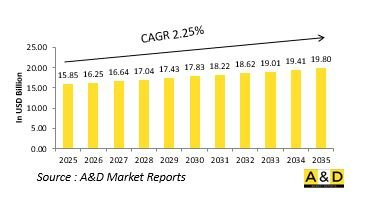
|
시장보고서
상품코드
1831821
세계의 레이더 시장(2025-2035년)Global Radar Market 2025-2035 |
||||||
세계의 레이더 시장 규모는 2025년에 추정 158억 5,000만 달러로, 2035년까지 198억 달러에 달할 것으로 예측되며, 예측 기간인 2025-2035년에 CAGR로 2.25%의 성장이 전망됩니다.

레이더 시장에서 기술의 영향
기술 혁신은 방위용 레이더의 상황을 크게 변화시켜 감지 능력, 적응성, 탄력성을 강화하고 있습니다. AESA(Active Electronic Scanning Array) 기술의 발전은 레이더 성능에 혁명을 가져왔으며, 하나의 시스템에서 목표물 포착 속도 향상, 추적 정확도 향상, 다중 임무 기능을 가능하게 했습니다. 디지털 빔포밍과 소프트웨어 정의 아키텍처는 실시간 재설정이 가능하며, 운영자가 진화하는 위협과 작전 요구사항에 유연하게 대응할 수 있도록 합니다. AI와 머신러닝의 통합은 예측 분석, 자동 목표물 분류, 작업자의 업무 부담 감소를 가능하게 함으로써 레이더 시스템을 더욱 강화합니다. 또한 스텔스 플랫폼이나 레이더 교란장치(ECM)에 대응하기 위해 양자 레이더와 패시브 감지 기술이 연구되고 있습니다. 네트워킹과 센서 융합은 레이더의 공동 운용을 가능하게 하고 종합적인 전장 인식을 제공하는 통합 감시 그리드를 형성하고 있습니다. 또한 신호 처리의 발전으로 스텔스 고속 표적 감지 능력이 향상되고 있습니다. 이러한 기술 개발은 레이더 시스템의 전략적 가치를 높일 뿐만 아니라, 레이더를 현대 국방 전략과 통합 지휘통제 네트워크의 중심이 되는 첨단 적응형 다중 역할 툴로 변화시키고 있습니다.
레이더 시장의 주요 촉진요인
여러 요인이 국방용 레이더 시장의 성장과 진화를 주도하고 있으며, 그 주요 요인은 현대의 위협의 복잡성과 상황 인식에 대한 관심 증가입니다. 스텔스 항공기, 극초음속 무기, 무인 항공 시스템의 보급으로 인해, 애매모호한 표적을 감지하고 추적할 수 있는 보다 민감하고 다용도한 레이더 솔루션의 필요성이 증가하고 있습니다. 지정학적 긴장, 영토 분쟁, 항공 및 해상 감시 구역의 확대로 인해 방위군은 장거리 및 고해상도 레이더 시스템에 대한 투자를 늘리고 있습니다. 또한 현대전의 멀티 도메인 전략으로의 전환은 통합 지휘체계와 실시간 데이터 공유를 지원하는 통합 레이더 네트워크의 개발을 촉진하고 있습니다. 또한 미사일 방어 구상과 대(對)드론 전략의 부상으로 레이더의 용도는 기존의 방공에 국한되지 않고 그 활용 범위가 넓어지고 있습니다. 현대화 계획에 대한 정부의 투자와 국방 예산 증가는 조달 및 연구개발 활동을 더욱 가속화하고 있습니다. 또한 국토 안보, 국경 감시, 우주 영역 파악의 중요성도 첨단 레이더 기능에 대한 수요를 촉진하고 있습니다. 이러한 촉진요인은 국방, 조기경보시스템, 평시 및 하이브리드 전쟁 상황 모두에서 작전 의사결정의 기본 요소로서 레이더의 지속적인 전략적 중요성을 강력히 시사합니다.
레이더 시장 지역별 동향
방산용 레이더 시장의 지역적 역학은 각 지역의 전략적 우선순위, 기술적 역량, 안보 이슈가 다르다는 것을 반영합니다. 북미는 통합 방공 및 미사일 방어, 우주 기지 감시, 레거시 레이더 시스템 현대화에 중점을 두고 있으며, 여전히 선두를 달리고 있습니다. 유럽은 지역 안보를 강화하고 상호운용성을 높이기 위해 방위동맹과 공동 프로그램을 통한 레이더 공동개발을 우선순위에 두고 있습니다. 아시아태평양은 영토 분쟁의 심화, 해양 안보 문제, 영공 방어 요건에 대응하기 위해 각국이 레이더 기술에 투자하면서 빠른 성장세를 보이고 있습니다. 중동 국가들은 지역 정세가 불안정해지면서 대미사일 방어와 국경 보안을 위해 레이더 솔루션에 집중하고 있습니다. 라틴아메리카와 아프리카에서는 영공 모니터링, 해안 감시, 밀수 대책의 필요성으로 인해 레이더에 대한 투자가 점차 증가하고 있습니다. 모든 지역에서 정부와 업계 진출 기업의 파트너십은 공급망을 강화하고 기술 이전을 가속화하고 있습니다. 레이더 국산화 및 국내 개발 프로그램 동향도 자생력을 강화하는 전략적 활동을 반영하여 증가하고 있습니다. 이러한 지역적 발전은 현대 국방 아키텍처에서 레이더가 전략적 억지력, 작전 인식, 진화하는 안보 상황에서의 협력적 대응을 위한 중요한 원동력으로서 레이더의 세계 중요성을 강조하고 있습니다.
세계의 레이더 시장에 대해 조사분석했으며, 성장 촉진요인, 향후 10년간 전망, 각 지역의 시장 동향과 예측 등의 정보를 제공하고 있습니다.
목차
레이더 시장 보고서의 정의
레이더 시장 세분화
지역별
컴포넌트별
플랫폼별
향후 10년간 레이더 시장 분석
레이더 시장의 기술
세계의 레이더 시장 예측
지역의 레이더 시장 동향과 예측
북미
촉진요인, 억제요인, 과제
PEST
시장 예측과 시나리오 분석
주요 기업
공급업체 Tier의 상황
기업 벤치마킹
유럽
중동
아시아태평양
남미
레이더 시장의 국가 분석
미국
방위 프로그램
최신 뉴스
특허
이 시장에서의 현재 기술 성숙도
시장 예측과 시나리오 분석
캐나다
이탈리아
프랑스
독일
네덜란드
벨기에
스페인
스웨덴
그리스
호주
남아프리카공화국
인도
중국
러시아
한국
일본
말레이시아
싱가포르
브라질
레이더 시장의 기회 매트릭스
레이더 시장 보고서에 관한 전문가의 의견
결론
Aviation and Defense Market Reports 소개
KSA 25.10.17The Global Radar market is estimated at USD 15.85 billion in 2025, projected to grow to USD 19.80 billion by 2035 at a Compound Annual Growth Rate (CAGR) of 2.25% over the forecast period 2025-2035.

Introduction to Radar Market:
The defense radar market is a cornerstone of modern military capability, providing critical situational awareness, threat detection, and surveillance functions across air, land, sea, and space domains. Radar systems serve as the eyes of defense forces, enabling early warning, target tracking, fire control, navigation, and airspace management. They are essential for monitoring hostile aircraft, missiles, naval vessels, and ground movements, as well as for supporting integrated command-and-control operations. As modern conflicts evolve to include stealth technologies, hypersonic weapons, and electronic warfare, the role of radar has become increasingly strategic. Militaries are prioritizing the deployment of advanced radar networks capable of multi-domain operation, enhanced range, and real-time data fusion. Additionally, the growing complexity of joint and coalition operations demands radar systems that can seamlessly share information across platforms and forces. The defense radar market is expanding beyond traditional applications to include missile defense, counter-drone operations, and space domain awareness. With radar forming the backbone of layered defense architectures, continuous innovation and modernization are critical to maintaining operational superiority, strategic deterrence, and rapid decision-making in complex and dynamic threat environments.
Technology Impact in Radar Market:
Technological innovation is profoundly reshaping the defense radar landscape, enhancing detection capabilities, adaptability, and resilience. Advances in active electronically scanned array (AESA) technology have revolutionized radar performance, enabling faster target acquisition, improved tracking precision, and multi-mission functionality within a single system. Digital beamforming and software-defined architectures allow for real-time reconfiguration, giving operators the flexibility to adapt to evolving threats and mission requirements. The integration of artificial intelligence and machine learning is further enhancing radar systems by enabling predictive analytics, automated target classification, and reduced operator workload. Emerging materials and compact designs are improving mobility and deployability, while quantum radar and passive detection technologies are being explored to counter stealth platforms and electronic countermeasures. Networking and sensor fusion are enabling radars to operate collaboratively, forming integrated surveillance grids that provide comprehensive battlespace awareness. Additionally, advances in signal processing are enhancing the ability to detect low-observable and high-speed targets. These technological developments are not only increasing the strategic value of radar systems but also transforming them into highly adaptive, multi-role tools central to modern defense strategies and integrated command-and-control networks.
Key Drivers in Radar Market:
Multiple factors are fueling the growth and evolution of the defense radar market, driven primarily by the rising complexity of modern threats and the increasing emphasis on situational awareness. The proliferation of stealth aircraft, hypersonic weapons, and unmanned aerial systems has heightened the need for more sensitive and versatile radar solutions capable of detecting and tracking elusive targets. Geopolitical tensions, territorial disputes, and the expansion of aerial and maritime surveillance zones are pushing defense forces to invest in long-range, high-resolution radar systems. Modern warfare's shift toward multi-domain operations is also promoting the development of integrated radar networks that support joint command structures and real-time data sharing. Additionally, the rise of missile defense initiatives and counter-drone strategies is expanding radar applications beyond conventional air defense. Government investments in modernization programs and increasing defense budgets are further accelerating procurement and R&D activities. The growing emphasis on homeland security, border surveillance, and space domain awareness is also driving demand for advanced radar capabilities. Together, these drivers underscore radar's enduring strategic importance as a fundamental component of national defense, early warning systems, and operational decision-making in both conventional and hybrid warfare scenarios.
Regional Trends in Radar Market:
Regional dynamics in the defense radar market reflect varying strategic priorities, technological capacities, and security challenges. North America remains a leader due to its focus on integrated air and missile defense, space-based surveillance, and modernization of legacy radar systems. Europe is prioritizing collaborative radar development through defense alliances and joint programs to strengthen regional security and enhance interoperability. The Asia-Pacific region is experiencing rapid growth as nations invest in radar technologies to address rising territorial disputes, maritime security concerns, and airspace defense requirements. Middle Eastern countries are focusing on radar solutions for counter-missile defense and border protection amid ongoing regional instability. In Latin America and Africa, radar investments are increasing gradually, driven by the need for airspace monitoring, coastal surveillance, and counter-smuggling operations. Across all regions, partnerships between governments and industry players are strengthening supply chains and accelerating technology transfer. The trend toward domestic radar production and indigenous development programs is also growing, reflecting strategic efforts to enhance self-reliance. These regional developments highlight radar's global significance in modern defense architectures, serving as a critical enabler of strategic deterrence, operational awareness, and coordinated response in evolving security landscapes.
Key Radar Program:
On Wednesday, March 12, 2025, the Union Ministry of Defence (MoD) signed a ₹2,906 crore contract with Bharat Electronics Limited (BEL), Ghaziabad, for the procurement of the Low-Level Transportable Radar (LLTR) system, Ashwini. According to the MoD, Ashwini is an active electronically scanned phased array radar built using advanced solid-state technology. The radar can track a wide range of aerial targets, from high-speed fighter jets to slow-moving objects such as helicopters and unmanned aerial vehicles. Its induction will greatly strengthen the operational readiness of the Indian Air Force.
Table of Contents
Radar Market - Table of Contents
Radar Market Report Definition
Radar Market Segmentation
By Region
By Component
By Platform
Radar Market Analysis for next 10 Years
The 10-year Radar Market analysis would give a detailed overview of radar market growth, changing dynamics, technology adoption overviews and the overall market attractiveness is covered in this chapter.
Market Technologies of Radar Market
This segment covers the top 10 technologies that is expected to impact this market and the possible implications these technologies would have on the overall market.
Global Radar Market Forecast
The 10-year radar market forecast of this market is covered in detailed across the segments which are mentioned above.
Regional Radar Market Trends & Forecast
The regional radar market trends, drivers, restraints and Challenges of this market, the Political, Economic, Social and Technology aspects are covered in this segment. The market forecast and scenario analysis across regions are also covered in detailed in this segment. The last part of the regional analysis includes profiling of the key companies, supplier landscape and company benchmarking. The current market size is estimated based on the normal scenario.
North America
Drivers, Restraints and Challenges
PEST
Market Forecast & Scenario Analysis
Key Companies
Supplier Tier Landscape
Company Benchmarking
Europe
Middle East
APAC
South America
Country Analysis of Radar Market
This chapter deals with the key defense programs in this market, it also covers the latest news and patents which have been filed in this market. Country level 10 year market forecast and scenario analysis are also covered in this chapter.
US
Defense Programs
Latest News
Patents
Current levels of technology maturation in this market
Market Forecast & Scenario Analysis
Canada
Italy
France
Germany
Netherlands
Belgium
Spain
Sweden
Greece
Australia
South Africa
India
China
Russia
South Korea
Japan
Malaysia
Singapore
Brazil
Opportunity Matrix for Radar Market
The opportunity matrix helps the readers understand the high opportunity segments in this market.
Expert Opinions on Radar Market Report
Hear from our experts their opinion of the possible analysis for this market.



















